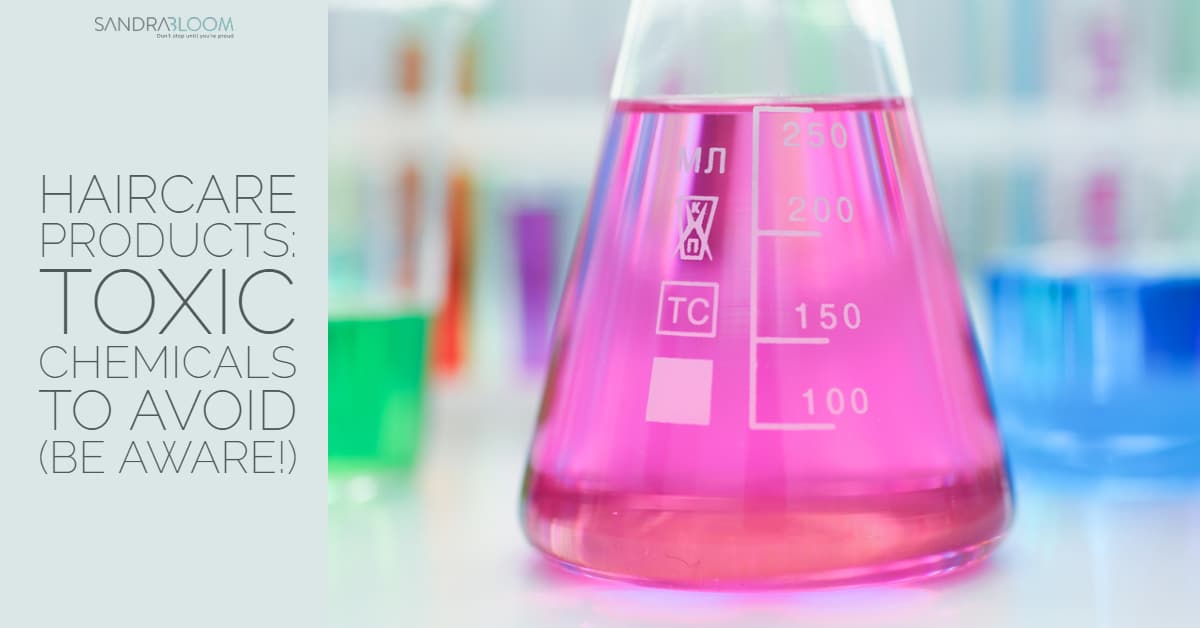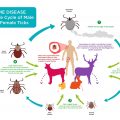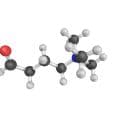Haircare products: toxic chemicals to avoid (be aware!)

Read on to learn about toxic the toxic chemicals to avoid in commercial haircare products!
For starters, I have an exercise I want you to do to learn about your haircare products and the toxic chemicals they contain you should avoid.
Now, go to your bathroom, collect your most used products (toothpaste, shampoo, moisturiser, etc.) and list all the ingredients on the label. Now look through them and tell me, do you know what they mean? I’m guessing that unless you’re a cosmetic scientist, you don’t, so why are you blindly trusting these products with your health and beauty?
You don’t need to use toxic chemicals in your haircare products to have beautiful hair
Besides, nature provides us with so many wonderful raw oils, herbs, botanicals and essential oils. Many kinds of butter are also beneficial to your skin and hair. So, you don’t necessarily need to expose yourself to harmful, toxic ingredients.
I began my holistic journey 10+ years ago. It was during this time that my home and diet became free of chemicals, but I only took the plunge and eliminated all toxic beauty products two years ago. I was obsessively researching about it and the information I found was SHOCKING.
Toxic chemicals / global industries manufactured over 84.000 chemicals since 1930
Since 1930, global industries manufactured over 84.000 toxic chemicals. None of these are nature’s inventions, and these compounds are slowly, but surely, killing us. Besides, most of these industrial toxins are neurotoxins, immunosuppressant, and carcinogens.
Dr Sponaugle from the Sponaugle Wellness detox clinic, where I’ve been fortunate enough to stay, says:
“Most of these toxins are lipophilic; fatty in molecular structure and fat-soluble. The cell membrane of every cell in our body consists of a lipophilic structure. Therefore, these lipophilic toxins can travel uninhibited throughout the body. These fatty toxins move throughout our bloodstream until they accumulate in our fattiest tissue, our neurological system.
“Our fattiest organ is our brain which consists of 60 percent fatty content. The fattiest tissue in our body, the myelin sheath on brain neurons and peripheral nerves consists of 80 percent fatty content, 25 percent of which is cholesterol, another reason cholesterol levels below 180 are detrimental to our brain and peripheral nervous system!”
1 in 8 of the 82000 beauty care ingredients contains industrial chemicals!
Further, according to the David Suzuki Foundation, 1 in 8 of the 82,000 ingredients used in health and beauty care products are industrial chemicals.
Another study by the National Academy of Sciences found that 95% of the chemicals used in synthetic fragrances contain toxic ingredients such as aldehydes, benzene derivatives (carcinogenic) and toluene, which are linked to central nervous disorders, cancer, congenital disabilities and allergies.
Toxic chemicals may lead to chronic inflammation
As you can imagine, industrial chemicals harm the environment and alter your health as well. Besides that, these chemicals lead to auto-immune diseases caused by inflammation in the body.
Unless you want to absorb carcinogens, pesticides, reproductive toxins and hormone disruptors daily, it’s important to remember that natural is the KEY if you don’t want to get TOX-SICK.
As you can imagine, industrial chemicals harm the environment and alter your health as well. As a consequence, this leads to auto-immune diseases caused by inflammation in the body.
Furthermore, our beauty care products are full of toxic chemical ingredients that make us sick and tired. So it is best to avoid them.
Toxic ingredients to avoid in haircare products
Obviously, we all have our tried and tested favourite haircare products and shampoos. Typically, we choose the one that smells good and leaves our hair feeling soft, shiny, and tamed.
However, most of us have never thought about the toxic beauty ingredients found in the hair products we love. Some feel that shampoo labels are like foreign-language documents!
Besides, too many commercial brands are guilty of using ingredients that wow your hair for a while, but eventually, strip your hair of moisture. To sum up, they break down hair proteins and ultimately lead to severe damage. Eventually, it can even cause serious health problems. So, we often hear about ingredients we should stop eating but why is it that we hear so little about the toxic chemicals we apply to our skin and hair?
Remember, our skin and hair absorb absolutely everything. All in all, we, especially women use lots of chemicals on our bodies every single day. Hence, these lead to a lot of build up inside our bodies, which can advance into a host of health and endocrine problems.
In conclusion, I eliminated them from my shopping list, and so should you. ASAP.
Toxic chemical beauty ingredients that lead to dry hair
Eye problems, toxic chemical beauty ingredients associate with Sodium laurel (SLS) Never apply this ingredient to your body. Unfortunately, most hair products contain SLS.
SLS is also super toxic to the environment, and a range of adverse side effects associate with it, including severe damage to hair (drying out).
Many big players in the haircare industry are placing your family’s health at risk with what they claim to be healthy shampoo.
Engine degreasers, garage car floor cleaners and industrial detergents contain SLS, yet we trustfully place this poison on our hair!
Other names for sodium laurel can hide their presence in your products. Look for the following equivalent names for sodium laurel:
Laureth sulphate (SLS)
Lauryl sulphate
Sodium Laureth sulphate
Ammonium laurel sulphate
Sodium dodecyl sulphate
Sulfuric acid
Sodium salt sulfuric acid
A12-00356
Akyposal SDS
Aquarex ME
Aquarex methyl
Toxic chemical beauty ingredients that lead to hair breakage
Notably, you should avoid the ingredient isopropyl alcohol at all costs. Also, avoid any skin and haircare products that contain alcohol. These chemicals dry out skin and hair; they simply aren’t good for the body.
Did you know that isopropyl alcohol is a key ingredient in antifreeze, shellac and wood finishes? This type of alcohol is used to dissolve oils. Therefore it strips the hair of its moisture. Most hair gels, volumizers, hairsprays and root lifters use alcohol to hold hairstyles in place, but it’s at the risk of hair breakage.
Consumer’s Dictionary warns that inhaling or ingesting alcohol may cause a stream of negative conditions: headaches, flushing, dizziness, mental depression, nausea, vomiting, narcosis and even coma.
Are you willing to jeopardise your health for shampoo?
Toxic chemical beauty ingredients that irritate the scalp
Propylene glycol (PG) is an ingredient often found in haircare products. It breaks down healthy hair proteins and cellular structures to give the appearance of smooth, shiny, healthy hair. Unfortunately, it also has many adverse side effects.
Propylene glycol is a chemical that irritates the skin, causes allergic reactions, and can alter skin structure. Once this happens, it allows other chemicals to penetrate deeper into the skin. In fact, it can impact your entire health with overexposure.
A concern for women is that propylene glycol links to reproductive health issues. It also potentially harms the brain and nervous system.
Other products that irritate the scalp are those containing diethanolamine (DEA) and triethanolamine (TEA). They can cause allergic reactions and destroy keratin, making your hair dry, brittle, and limp.
Synthetic colouring agents: toxic chemical beauty ingredients that cause scalp irritation
Artificial colour added to haircare products can cause skin and scalp irritations. You can identify artificial colours by the codes ‘FD&C’ and ‘D&C’.
Haircare products and Toxic Chemical beauty ingredients that Make Hair Brittle
Many shampoos use Polyethylene glycol (PEG) as a thickening agent.. Unfortunately, it strips hair and skin of natural moisture.
PEG is used to dissolve oil and grease build up on hair. Unless you’re regularly deep-frying your hair, chances are you won’t need such harsh chemicals. Keep this chemical in your kitchen!
On a serious note, though – when cleaning I stick to essential oils like tea tree oil, lemon oil, and vinegar. I avoid chemical products. They are too toxic and would build up in the air inside my home. I am not used to it anymore, and when I enter places where they clean with toxic chemicals, I start feeling unwell and nauseous.
Toxic chemicals linked to cancer and immune and neurotoxicity
Parabens are found in makeup, moisturisers, hair, bath and shaving products. They act as an antimicrobial preserving agent. However, they aren’t good for the body.
The toxic nature of parabens is well documented. They cause immune problems and neurotoxicity. Parabens mimic oestrogens. They link to cancer, skin irritation and reproductive problems. On labels, parabens are identified by words like butylparaben, ethylparaben and methylparaben.
Formaldehyde is a chemical found in many haircare products and some nail polishes. It is colourless, yet has a very, strong smell. It is a chemical used for embalming, in building materials and to produce various household products. Excessive exposure to formaldehyde (from beauty products) leads to hair loss.
Formaldehyde is also linked to cancer. It is toxic and can lead to asthma when inhaled. As a known carcinogen, it’s criminal that the beauty industry still uses it.
Fragrances… They sound harmless, right?
Fragrances are usually made up of a complex mix of chemicals. For example, a single fragrance can contain up to 3 thousand chemicals. Fragrances are linked to breast cancer and reproductive problems. The average consumer is completely unaware of this. Many fragrances also irritate the scalp.
Lanolin, petroleum, and mineral oils are by-products of oil.
They are commonly used in lotions, creams, ointments and cosmetics, yet they have no real moisturising benefits. Instead, these ingredients weigh down hair and prevent natural oils from being absorbed by the hair shaft.
Petroleum-based products may also be contaminated with toxins. They tend to clog pores and hair shafts.
Dimethicone and Acne
Dimethicone is a synthetic polymer. It’s a silicone oil that is extremely popular in beauty products. People with sensitivities to silicone can get skin and scalp irritations, like chapped skin, burning, itching and rashes.
Dimethicone coats the hair (or skin) and seals in moisture. It does this so well; it doesn’t allow skin to breathe. This is what causes irritation to hair follicles, shedding and skin acne.
Why should you ditch products containing these ingredients? Dimethicone can cause skin mutations and issues with the liver, lymph nodes and other internal organs.
Avoid these ingredients at all costs
When you shop for healthy hair products, as much as possible, avoid toxic ingredients.
Take the list below with you as a reference:
Mineral oil, silicone, propylene glycol, PEG, ALES, fragrance, polycyclic musks, animal by-products, Petrolatum or Paraffin wax, parabens, ethanolamines, SLES, synthetic dye, phthalates, synthetic retinol, animal testing,
Shocking facts about hair dye – think twice before you go to the salon
1. Beware of Hair Dye
People have been dying their hair for decades, so why the concern? Well, the dirty little industry secret is that hair dyes contain thousands of chemicals. These include cancer-causing ingredients (carcinogens).
2. The ‘Relationship’ – Rheumatoid Arthritis and Hair Dye
Recent studies have found a link between use of hair dyes and rheumatoid arthritis (RA). This condition is a painful, chronic illness that disfigures people and halts their physical abilities.
3. Hair Colour Can Discolour Your Skin or Kill You
An extremely toxic chemical found in most hair dyes is paraphenylenediamine. Don’t ask me to pronounce it!
This highly toxic chemical causes methemoglobinemia (can’t pronounce that either!) which restricts oxygen and causes the skin to turn a bluish/grey colour. Methemoglobinemia can be fatal.
4. Avoid Poisonous Lead in Hair Dyes
Hair dye contains lead. Did you know that? It seems unimaginable since the scientific community has told us for years that lead is deadly but the darker your hair dye, the more likely it is to contain lead. Look for the word ‘acetate’ in the list of ingredients and avoid it at all costs.
5. Cancer Risks in Infants
If you are carrying a baby avoid dyeing your hair. A growing foetus is vulnerable at any stage, so it’s not worth the risk. Everything that you consume, whether orally or transdermally (through the skin), trickles down to your unborn baby. Chemicals can have a devastating effect on them.
6. Increases Cancer Risk in Adults
Cancer rates are on the rise. This fact doesn’t surprise me, since nowadays we’re bombarded by chemicals in everyday products, including hair dyes. Why not replace your commercial hair dye for a natural, colouring alternative, like henna? This way you can avoid unnecessary exposure to toxic, cancer-causing chemicals.
Other toxic chemicals to watch out for in everyday beauty and haircare products
TALC
Recent studies have found that talc, mostly found in makeup and baby products, is linked to ovarian and testicular cancer.
ALUMINIUM
Researchers have found that aluminium can cause DNA changes, which could potentially lead to cancer. (Including breast-cancer) Check your deodorants labels and look if it contains aluminium!
TETRASODIUM EDTA
This chemical is toxic to living cells and can damage DNA.
DIOXINS
According to the Skin Deep Cosmetic Database, dioxins are linked to cancer, can be toxic to organs and affect development.
CETEARETH-20
Some hair removal products contain chemicals like Ceteareth-20, which is usually contaminated with other toxic chemicals.
CHLORHEXIDINE GLUCONATE
To go on, this chemical, which can be found in contact lens cleaner, can cause allergies and irritation and has already been restricted in Japan and Canada.
TOXIC CHEMICALS IN DEODORANT
Further, many deodorants contain aluminium and propylene glycol, which can cause skin irritation. There’s also some evidence that suggests propylene glycol can cause cancer, reproductive complications, developmental abnormalities, neurotoxicity or endocrine complications.
SANITARY PADS AND TAMPONS
Think about how many days you spend wearing sanitary pads or tampons – surely, you’d want something that’s in contact with your skin for so long to be non-toxic and safe?
Sanitary pads can also contain toxic ingredients that absorb into your bloodstream and contain bleach and non-organic GMO cotton.
Furthermore, the organisation EcoFriend stated that: “Conventional cotton farming uses approximately 25% of the world’s insecticides and more than 10% of the pesticides (including herbicides, insecticides and defoliants).”
Because of this, the result is that thousands of women experience allergic reactions to pads and tampons. This is unsurprising when you consider that many of the ingredients on sanitary products remain undisclosed.
To avoid having to cope with these symptoms, you could try menstrual cups.
Holistic solutions to regrow hair, clean living and optimal health
If you would like to discover more natural and holistic solutions to regrow hair ensure to check out the regrow hair solutions page.
Or to discover more information about cleaning living and holistic lifestyle, explore my optimal health page.
Check out the best essential oils to regrow stronger and thicker hair page
My favourite natural and toxin-free organic brands for my hair care are:
- Khadi: Herbal colouring with Henna, herbs and plant pigments
- Morrocco-Method: Herbal colouring with Henna, herbs and plant pigments
- Plant Therapy : Therapeutic and food-grade essential oils
- Ancient Apothecary: Therapeutic and food-grade essential oils
- Pukka: My favourite brand for Castor oil.
Empowering others via my anti-ageing wellness platform and holistic health books
I hope you liked this page about conventional hair loss treatments. If you would like to learn more about my tips and tricks on how to live a toxin-free life or how I saved my hair from falling ensure to check out other pages of this anti-ageing wellness platform.
Or if you want to discover my no BS guides on how to regain your health, hair and life, ensure to check out my holistic anti-ageing wellness books
After a frustrating decade of battling several chronic illnesses, I became disillusioned with the medical system and decided to take my health into my own hands.
Now, through my books and wellness platform, I want to empower people around the world do the same and regain their health, hair, life and beauty!
Let me help you right now!
Receive YOUR Welcome Kit that includes a wide range of topics, from simple and easy healthy brain recipes to clean living, ditching toxic chemicals with loads of practical advice that you can implement immediately
.




